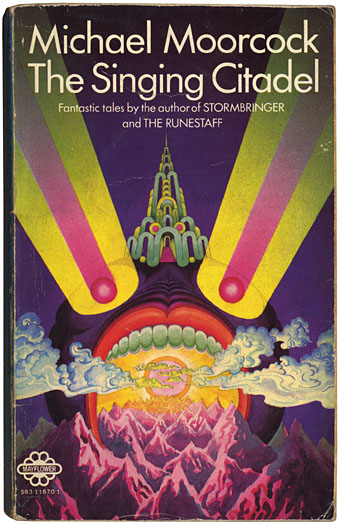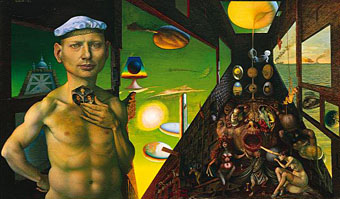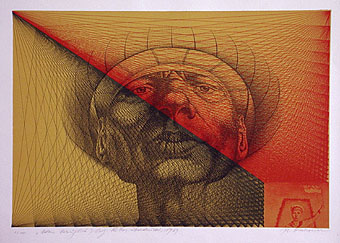XII Festival de Almagro (1989).
Dura el Tránsito (1981).
José Hernández Spanish painter and engraver.
Update: José Hernandez at Velly.org.
Elsewhere on { feuilleton }
• The fantastic art archive
• The etching and engraving archive
A journal by artist and designer John Coulthart.
Fantasy
XII Festival de Almagro (1989).
Dura el Tránsito (1981).
José Hernández Spanish painter and engraver.
Update: José Hernandez at Velly.org.
Elsewhere on { feuilleton }
• The fantastic art archive
• The etching and engraving archive
Still Warm Sand (2003).
Iron Grasshopper (2006).
Elsewhere on { feuilleton }
• The fantastic art archive

The Singing Citadel (1970).
Michael Moorcock’s Elric books are being prepared for republication by Del Rey in the US next year. I’ve assisted with some minor parts of this preparation, including sourcing pictures from Savoy’s edition of Monsieur Zenith the Albino. (Anthony Skene’s albino anti-hero is a precursor of Moorcock’s albino anti-hero.)
Discussion of the Elric books with Dave at Savoy prompted my excavation of this battered Mayflower paperback from the retired book boxes. This slim volume collected four fantasy stories: the title piece (possibly the first Elric story I read), Master of Chaos, The Greater Conqueror and To Rescue Tanelorn…. I’d forgotten about the garishly strange cover, one of many that Bob Haberfield produced for Moorcock’s books during the 1970s. Haberfield is one of a number of cover artists from that period who worked in the field for a few years before moving on or vanishing entirely. The swirling clouds derived from Tibetan Buddhist art identify this as one of his even without the credit on the back; later pictures were heavily indebted to Eastern religious art and while technically more controlled they lack this cover’s berserk intensity. Haberfield’s site has a small gallery of his splendid paintings, including a rare horror work, his wonderfully eerie cover for Dagon by HP Lovecraft.
Searching for more Haberfield covers turned up these two examples, both part of the SciFi Books Flickr pool, a cornucopia of pictures by vanished illustrators. Browsing that lot is like being back inside the In Book Exchange, Blackpool, circa 1977. The digitisation of the past continues apace at the Old-Timey Paperback Book Covers pool and the Pulp Fiction pool. Don’t go to these pages if you’re supposed to be doing something else, it’s easy to find yourself saying “just one more” an hour later.
And in other Moorcock-related news, Jay alerts me today to the existence of an archive of New Worlds covers, something I’d been hoping to see for a long time. New Worlds was one of the most important magazines of the 1960s, mutating under Moorcock’s editorship from a regular science fiction title to a hothouse of literary daring and experiment. As with so many things in that decade, the peak period was from about 1966–1970 when the magazine showcased outstanding work from Moorcock himself, JG Ballard, Brian Aldiss, Harlan Ellison, Samuel Delany, M John Harrison, Norman Spinrad and a host of others. For a time it seemed that a despised genre might be turning away from rockets and robots to follow paths laid down by William Burroughs, Salvador Dalí, Jorge Luis Borges and other visionaries. We know now that Star Wars, Larry Niven and the rest swept away those hopes but you can at least go and see covers that pointed to a future (and futures) the world rejected.
Elsewhere on { feuilleton }
• The book covers archive
• The illustrators archive
Previously on { feuilleton }
• Barney Bubbles: artist and designer
• 100 Years of Magazine Covers
• It’s a pulp, pulp, pulp world
There’s no place like home (2006).
Now here’s an artist—Italian, works in NYC—who makes most painters look like they’re slacking. No need to post more tiny jpegs when you can go to his site and see his extraordinary tempest-tossed cowgirls at a larger size. And there’s more oil-on-canvas mayhem at the Stux Gallery, New York.
Elsewhere on { feuilleton }
• The fantastic art archive

Die Arche des Odysseus (1948–1956).

Adam Bei Sich (1969).
A major Austrian painter and printmaker, Rudolf Hausner studied art at the Academy in Vienna from 1931 to 1936, under Fahringer and Sterrer. Many of his early paintings were confiscated and branded as ‘degenerate’ by the ruling Nazi party in 1938. In 1941 Hausner was drafted by the German army and remained a soldier until the war’s end in 1945. After the war he returned to Vienna and immersed himself in studies dealing with the unconscious and with the art of Surrealists, particularly that of Max Ernst. Along with Wolfgang Hutter and Anton Lehmden, Rudolf Hausner founded the Viennese School of Fantastic Realism in 1947. During the 1950s and 1960s this became one of Austria’s most important movements and Hausner was its most influential artist. During this time he also held principal teaching posts at the academies of Vienna and Hamburg.
Equally gifted as a painter, lithographer and etcher, Hausner’s complex art is based upon potent symbols and imagery. Primary among these is the constantly recurring image of the first man, Adam, who is part autobiographical and part archetype. Another compelling image is that of the man or boy in a sailor’s cap. Hausner claimed that this image symbolized the myth of Odysseus and his epic voyages on the seas. It also, however, is representative of the artist’s own boyhood and the integrated relationships of youth and age within the self.
Elsewhere on { feuilleton }
• The fantastic art archive